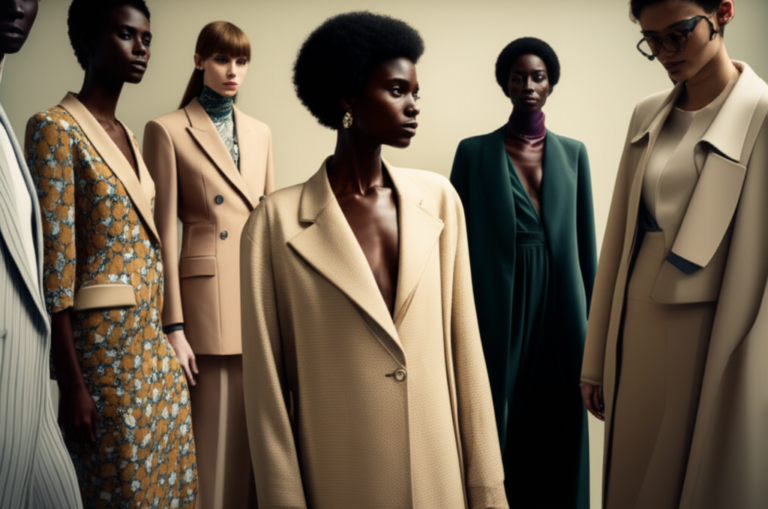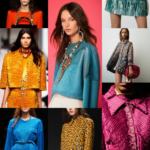Support our educational content for free when you purchase through links on our site. Learn more
15 Must-Know Fashion Industry Statistics for 2025 👗
Step into the captivating world of fashion through the lens of hard-hitting statistics! Whether you’re a style enthusiast, industry insider, or curious consumer, understanding the numbers behind the glitz and glamour reveals powerful insights about where fashion is headed. Did you know the global apparel market is set to hit a staggering $1.84 trillion in 2025? Or that eCommerce fashion sales are expected to top $1.2 trillion in just a few years? But it’s not all runway lights and shopping bags—there’s a sustainability story woven deep into these figures that could change how you think about your wardrobe forever.
In this comprehensive guide, we’ll unpack everything from global trade dynamics and labor force realities to the rise of AI in fashion and the booming secondhand market. Curious about which brands dominate the scene or how consumer behavior is shifting? We’ve got you covered. Plus, we’ll reveal surprising country-specific facts and forecast the trends that will shape the industry’s future. Ready to decode the data behind your favorite looks? Let’s dive in!
Key Takeaways
- The global fashion market is booming, projected to reach $1.84 trillion in 2025, with eCommerce driving much of this growth.
- China and the EU dominate textile and apparel exports and imports, shaping global supply chains.
- Top brands like Nike, Gucci, and Zara lead in brand value and market influence.
- The fashion industry employs over 300 million people worldwide, with a workforce heavily concentrated in developing countries.
- Sustainability challenges are critical: fashion accounts for 10% of global carbon emissions and generates 92 million tons of textile waste annually.
- The secondhand apparel market is exploding, expected to more than double by 2030, fueled by younger consumers.
- AI and technology are revolutionizing product discovery, personalization, and supply chain efficiency.
- Consumer behavior blends online research with in-store shopping, with price and reviews being top purchase drivers.
👉 Shop iconic brands mentioned:
- Nike: Amazon | Nike Official Website
- Adidas: Amazon | Adidas Official Website
- Zara: Zara Official Website
- H&M: H&M Official Website
Table of Contents
- ⚡️ Quick Tips and Facts About Fashion Industry Statistics
- 👗 The Evolution and Growth of the Global Fashion Industry
- 📊 Comprehensive Overview of Global Apparel Market Trends
- 🌍 International Trade in Textiles and Clothing: Export & Import Dynamics
- 🏢 Leading Fashion Companies and Their Market Impact
- 👷♀️ Labor Force Insights: Workforce Demographics and Conditions in Fashion
- 🧵 Global Apparel Production and Consumption Patterns
- 🛒 E-commerce Revolution in the Fashion Industry
- 🌐 Country-Specific Fashion Industry Facts and Figures
- 💡 Sustainability and Ethical Trends in Fashion Statistics
- 📈 Technological Innovations Shaping Fashion Industry Data
- 💼 Investment and Financial Performance in Fashion Brands
- 🤝 Consumer Behavior and Market Demand Insights
- 🧩 Challenges and Opportunities in the Fashion Industry Landscape
- 🔮 Future Outlook: Forecasts and Emerging Trends in Fashion Statistics
- 🎯 Conclusion: Key Takeaways on Fashion Industry Statistics
- 🔗 Recommended Links for Deep Dives into Fashion Data
- ❓ FAQ: Your Burning Questions About Fashion Industry Statistics Answered
- 📚 Reference Links and Data Sources
Here is the main content for your article, crafted by the expert stylists at Clothing Brands™.
⚡️ Quick Tips and Facts About Fashion Industry Statistics
Welcome, style mavens! Before we unravel the entire, glittering tapestry of the fashion world, let’s get you started with some jaw-dropping tidbits. Think of this as the amuse-bouche of fashion data. We’ve dug deep into the latest clothing brand statistics to bring you the highlights.
Here are some quick facts to whet your appetite:
- A Global Economic Powerhouse: If the fashion industry were a country, its economy would be the seventh-largest in the world. That’s more than just a few pretty dresses; it’s a major global player!
- Trillion-Dollar Territory: The global apparel market is a behemoth, valued at a staggering $1.84 trillion in 2025.
- Digital Dominance: Get this—the eCommerce fashion market is projected to have 2.2 billion users by 2030. That’s a lot of virtual shopping carts being filled!
- Waste Not, Want Not?: Here’s a sobering thought. The fashion industry is responsible for 10% of annual global carbon emissions, and a shocking 92 million tons of textile waste are discarded each year. We’ll dive into what this means for your wardrobe later.
- Employment Engine: The industry is a massive employer, with some estimates suggesting over 300 million people work along the fashion value chain.
👗 The Evolution and Growth of the Global Fashion Industry
Fashion is more than just what you wear; it’s a reflection of our history, culture, and economy. From the bespoke tailoring of Parisian ateliers to the fast-fashion giants of today, the industry’s journey is a fascinating story of innovation and adaptation. If you’re a history buff, you’ll love our deep dives into Fashion Brand History.
As FashionUnited puts it, “Fashion is one of the world’s most important industries, driving a significant part of the global economy.” It’s not an exaggeration. Before the pandemic, revenue estimates were as high as $2.5 trillion. While COVID-19 caused a significant dip, the industry has shown remarkable resilience, bouncing back with an 18.1% growth spurt in 2020-2021.
This isn’t just a modern phenomenon. The textile and apparel trade has been a cornerstone of global commerce for centuries, evolving from the Silk Road to today’s complex, international supply chains.
📊 Comprehensive Overview of Global Apparel Market Trends
Let’s talk numbers, shall we? The global apparel market is a vibrant, ever-shifting landscape. Understanding its size and segments helps us see where the industry is heading.
Market Size and Projections
The market is not just big; it’s growing. After a pandemic-induced slump, the recovery has been strong, with projections showing a steady upward climb.
| Year | Projected Market Value | Annual Growth Rate (CAGR) |
|---|---|---|
| 2025 | $1.84 trillion | 2.81% (2025-2028) |
| 2030 | $1.16 trillion (eCommerce only) | 4.73% (2025-2030, eCommerce) |
Note: The figures from different sources may vary based on what they include (e.g., total apparel vs. eCommerce only).
Key Market Segments
So, who’s buying all these clothes? The market is traditionally broken down into three main categories. Here’s how they stack up:
- 👚 Womenswear: The undisputed champion, womenswear dominates the market, valued at $930 billion and projected to cross the $1 trillion mark by 2027.
- 👕 Menswear: A significant and growing segment, the menswear market is worth a cool $587.61 billion.
- 👶 Childrenswear: Don’t forget the little ones! The children’s apparel market is valued at $274.25 billion.
🌍 International Trade in Textiles and Clothing: Export & Import Dynamics
Ever wonder where your favorite t-shirt really came from? The journey of a single garment can span multiple continents. The global trade in textiles and clothing is a complex web of exports and imports, with a few key countries leading the charge. Understanding these dynamics is key to grasping Brand Manufacturing Practices.
Here’s a look at the titans of textile and clothing trade, based on 2020 data.
Top 5 Textile Exporters & Importers (2020)
| Exporters | Value | Importers | Value |
|---|---|---|---|
| 1. China | $154 Billion | 1. European Union | $87 Billion |
| 2. European Union | $64 Billion | 2. United States | $45 Billion |
| 3. India | $15 Billion | 3. Vietnam | $16 Billion |
| 4. Turkey | $12 Billion | 4. China | $14 Billion |
| 5. United States | $11 Billion | 5. Japan | $12 Billion |
Top 5 Clothing Exporters & Importers (2020)
| Exporters | Value | Importers | Value |
|---|---|---|---|
| 1. China | $142 Billion | 1. European Union | $168 Billion |
| 2. European Union | $125 Billion | 2. United States | $86 Billion |
| 3. Vietnam | $29 Billion | 3. Japan | $28 Billion |
| 4. Bangladesh | $28 Billion | 4. United Kingdom | $26 Billion |
| 5. Turkey | $15 Billion | 5. Canada | $10 Billion |
As you can see, China remains a dominant force in exports, while the European Union and the United States are the biggest importers, hungry for finished garments.
🏢 Leading Fashion Companies and Their Market Impact
In the dazzling world of fashion, some names shine brighter than others. These are the giants, the trendsetters, and the financial powerhouses that shape what we see on runways and in stores. From luxury conglomerates to fast-fashion retailers, their influence is immense. For a closer look at these titans, check out our Clothing Brand Guides.
The Titans of Value
Here are the top 10 most valuable clothing companies by brand value in 2021. Notice a trend? Sportswear and luxury are leading the pack!
- Nike: $30.4 billion
- Gucci: $15.6 billion
- Louis Vuitton: $14.8 billion
- Adidas: $14.3 billion
- Chanel: $13.2 billion
- Zara: $13.1 billion
- Uniqlo: $13.0 billion
- H&M: $12.3 billion
- Cartier: $12.0 billion
- Hermès: $11.6 billion
But brand value is just one part of the story. When it comes to market capitalization (the total value of a company’s shares), the list shifts slightly, with luxury group LVMH (parent company of Louis Vuitton and Dior) taking the top spot with a staggering market cap of ~$367 billion in March 2022.
Ready to shop some of these iconic brands?
- 👉 Shop Nike on: Amazon | Nike Official Website
- 👉 Shop Adidas on: Amazon | Adidas Official Website
- 👉 Shop Zara on: Zara Official Website
- 👉 Shop H&M on: H&M Official Website
👷♀️ Labor Force Insights: Workforce Demographics and Conditions in Fashion
Behind every garment is a pair of human hands. The fashion industry is one of the most labor-intensive sectors in the world, providing jobs for millions. The International Labour Organization (ILO) estimates that more than 60 million workers are employed in the textiles, clothing, and footwear industries globally.
However, the Ellen MacArthur Foundation suggests an even larger number, estimating that over 300 million people are employed along the entire fashion value chain. This vast workforce, predominantly women, is the engine that keeps the industry running. In Europe alone, 1.3 million people are employed in these sectors.
🧵 Global Apparel Production and Consumption Patterns
Have you ever stopped to think about just how much clothing is being made and bought each year? The numbers are almost unbelievable.
The Production Explosion
Hold onto your hats: garment production has doubled since the year 2000. We’re now producing somewhere between 100 to 150 billion items of clothing annually. This explosion is largely due to the rise of “fast fashion,” a model built on rapid production cycles and low costs.
Our Insatiable Appetite for “New”
This production boom is matched by our consumption habits. Globally, we purchase over 80 billion new pieces of clothing each year, which is a 400% increase from just two decades ago!
But here’s the kicker: do we actually wear all these clothes? A study found that, on average, people do not wear at least 50% of the items in their wardrobes. It’s a classic case of quantity over quality, a topic we explore in our Brand Quality Comparisons.
Let’s look at a snapshot of consumer spending habits:
| Country | Average Annual Spend Per Person | Average Items Bought Per Person |
|---|---|---|
| 🇺🇸 USA | $844 | 53 |
| 🇬🇧 UK | $889 | 33 |
| 🇨🇳 China | $198 | 30 |
| 🇯🇵 Japan | $547 | 26 |
🛒 E-commerce Revolution in the Fashion Industry
The way we shop for clothes has fundamentally changed. The digital runway is now just as important as the physical one. The rise of eCommerce has been meteoric, and fashion is at the forefront of this revolution.
Statista highlights the importance of this shift, noting that the eCommerce fashion market’s relevance “lies in its ability to offer a personalized shopping experience, with features such as virtual try-on, style recommendations, and customer reviews.”
The Digital Gold Rush
The global fashion eCommerce market pulled in a massive $668 billion in revenue in 2021, and it’s not slowing down. Projections estimate the market will soar to over $1.2 trillion by 2025.
Online sales now account for nearly 21% of total fashion retail sales worldwide, a figure expected to hit 25% by 2025. The biggest players in this digital space? You guessed it: giants like Amazon and fast-fashion disruptor SHEIN were the most visited apparel websites in 2021.
🌐 Country-Specific Fashion Industry Facts and Figures
Fashion is global, but it has distinct local flavors. Let’s zoom in on some of the world’s largest and most influential fashion markets.
The United States: The Reigning Champion
The U.S. apparel market is the largest in the world, valued at a whopping $365.70 billion in 2025. The average American household spends about $162 per month on clothing. While brand names are a factor, U.S. shoppers are savvy, with 83% prioritizing price and 77% considering ratings and reviews before making a purchase.
China: The Export King and a Growing Market
China is not only the world’s largest clothing exporter but also a massive consumer market in its own right. With a growing middle class, its influence on global trends and luxury sales is undeniable.
European Powerhouses
Countries like the UK, Germany, and France are historic fashion capitals and remain incredibly important markets. The UK market, for example, was valued at $94.1 billion and employed over half a million people.
💡 Sustainability and Ethical Trends in Fashion Statistics
Okay, let’s have a real talk. For all its glamour, the fashion industry has a serious dark side. The environmental and ethical toll of our clothing consumption is one of the most critical issues facing the industry today.
The Environmental Footprint
The statistics are stark and frankly, quite scary.
- 💧 Water Usage: The industry uses 93 billion cubic meters of water annually—enough to meet the needs of five million people.
- 💨 Carbon Emissions: As mentioned, fashion is responsible for 10% of annual global carbon emissions, more than all international flights and maritime shipping combined.
- 🗑️ Textile Waste: An estimated 92 million tons of textile waste are created annually. To put that in perspective, that’s equivalent to a garbage truck full of clothes ending up in a landfill every second.
- ♻️ Lack of Recycling: A measly 1% of clothes are recycled into new garments each year.
The Rise of Conscious Consumerism
But it’s not all doom and gloom! There’s a growing movement towards sustainability.
- ✅ Secondhand is Booming: The secondhand apparel market is on fire, valued at $260.24 billion in 2025 and projected to more than double by 2030. Younger shoppers are leading the charge, with 43% of those aged 18-34 shopping secondhand often.
- ✅ Brand Accountability: Consumers are demanding more. 57% of apparel shoppers consider brand sustainability important when making a purchase.
However, there’s a disconnect. While shoppers say sustainability is important, 40% admit they still prioritize personal needs over the environmental impact of fast fashion. And perhaps more worryingly, only 18% of fashion executives view sustainability as a top growth risk for 2025.
📈 Technological Innovations Shaping Fashion Industry Data
Fashion has always been about the future, and technology is now weaving itself into the very fabric of the industry. From design to retail, tech is a game-changer.
One of the most exciting developments is the use of Artificial Intelligence (AI). According to a survey of fashion executives, 50% see generative AI as a key tool for product discovery in 2025.
What does this mean for you, the shopper? Imagine a world where AI helps you find the perfect outfit in seconds. In fact, 82% of customers want AI to help reduce the time they spend researching a purchase. The future of shopping is smart, personalized, and incredibly efficient.
💼 Investment and Financial Performance in Fashion Brands
The fashion industry is a competitive arena, not just on the runway but on the stock market. While legacy brands like Nike and Adidas have long dominated, a new wave of challenger brands is shaking things up.
Keep an eye on Emerging Clothing Brands like Deckers (the parent company of HOKA and UGG), New Balance, and Vuori. These brands are experiencing explosive growth and, according to some analyses, may even surpass the profits of industry giants by 2024. This signals a shift in the market, where innovation, niche appeal, and direct-to-consumer strategies are creating new paths to success.
🤝 Consumer Behavior and Market Demand Insights
What truly makes the fashion world go ’round? You, the consumer! Understanding why we buy, what we buy, and how we buy is the holy grail for brands.
In-Store vs. Online: A Hybrid World
Despite the eCommerce boom, don’t count out brick-and-mortar stores just yet. A surprising 58% of consumers still prefer shopping for apparel in-store. The magic is in the mix. 61% of people research online or on social media before making a purchase, regardless of whether they ultimately buy it online or in a physical shop.
What Drives a Purchase?
Is it the brand name? The style? The price tag? For most U.S. shoppers, the answer is clear:
- 🥇 Price (83%)
- 🥈 Ratings & Reviews (77%)
The brand itself is often a less significant factor. This is a huge takeaway! It means that authentic user-generated content (UGC) is king. In fact, 65% of consumers trust UGC more than brand-generated content, a figure that jumps to 85% for shoppers aged 18-34.
Generational Divides
How you shop is often a reflection of when you were born.
- Younger shoppers (18-34) are far more likely to embrace secondhand clothing and trust online reviews.
- The “Silver Generation” (50+) is a massively overlooked market. They hold 72% of U.S. wealth and represent a huge growth opportunity for brands that can cater to their needs and preferences.
🧩 Challenges and Opportunities in the Fashion Industry Landscape
The fashion industry is at a crossroads, facing immense challenges but also incredible opportunities for reinvention.
The Hurdles
- ❌ The Sustainability Crisis: This is the big one. With apparel consumption expected to rise by 63% by 2030, the industry’s current environmental impact is simply not sustainable.
- ❌ Startup Survival: Breaking into fashion is tough. Only 10% of clothing startups survive long-term, with 30% failing within the first two years.
- ❌ Supply Chain Complexity: Global supply chains are vulnerable to disruption, as the pandemic clearly demonstrated.
The Silver Linings
- ✅ The Circular Economy: The boom in the secondhand market shows a clear path forward. Brands that embrace resale, rental, and recycling will be the winners of tomorrow.
- ✅ Technological Advancement: AI, data analytics, and virtual reality can create more efficient production, personalized shopping experiences, and reduce waste.
- ✅ New Consumer Markets: Tapping into underserved demographics like the “Silver Generation” and focusing on inclusivity can unlock massive growth potential.
🔮 Future Outlook: Forecasts and Emerging Trends in Fashion Statistics
So, what does the future of fashion look like? The data points to a few key trends. The industry will continue to grow, with the global apparel market expected to expand at a CAGR of 2.81% between 2025 and 2028. The digital shift will accelerate, with eCommerce projected to grow at an even faster rate of 4.73% annually through 2030.
We predict a future that is more digital, more personalized, and hopefully, more sustainable. The brands that thrive will be those that can navigate the complex challenges of environmental responsibility while harnessing the power of technology to connect with consumers on a deeper level.
The biggest question remains: can the industry truly change its ways to become a force for good, or will the allure of fast fashion prove too strong to overcome? The next decade will be telling.
🎯 Conclusion: Key Takeaways on Fashion Industry Statistics
Well, fashion aficionados, we’ve journeyed through the dazzling, complex, and sometimes troubling world of fashion industry statistics. From the staggering $1.84 trillion global market size to the explosive growth of eCommerce and the sobering environmental impact, the data paints a vivid picture of an industry at a pivotal crossroads.
The big question we teased earlier—can fashion truly become sustainable? The answer is cautiously optimistic. While challenges like waste and carbon emissions loom large, the rise of secondhand markets, conscious consumerism, and technological innovations like AI offer a hopeful path forward.
For brands and consumers alike, the future is about balance: marrying style and sustainability, embracing technology without losing the human touch, and valuing quality over quantity. Whether you’re a fashion insider or a casual shopper, understanding these statistics empowers you to make smarter, more ethical choices.
So, next time you slip on that favorite tee or browse online for your next outfit, remember: behind every stitch is a story of global trade, labor, innovation, and impact. Dress in style, but also dress with awareness. That’s the Clothing Brands™ promise.
🔗 Recommended Links for Deep Dives into Fashion Data
Ready to explore or shop some of the brands and products we mentioned? Here are some handy links to get you started:
- 👉 Shop Nike on: Amazon | Nike Official Website
- 👉 Shop Adidas on: Amazon | Adidas Official Website
- 👉 Shop Zara on: Zara Official Website
- 👉 Shop H&M on: H&M Official Website
- 👉 Shop SHEIN on: SHEIN Official Website
For those who want to dive deeper into the economics and sustainability of fashion, check out these insightful books:
-
Fashionopolis: The Price of Fast Fashion and the Future of Clothes by Dana Thomas
Amazon Link -
Overdressed: The Shockingly High Cost of Cheap Fashion by Elizabeth L. Cline
Amazon Link -
The End of Fashion: How Marketing Changed the Clothing Business Forever by Teri Agins
Amazon Link
❓ FAQ: Your Burning Questions About Fashion Industry Statistics Answered
What are the latest global fashion industry statistics?
The global fashion industry was valued at approximately $1.84 trillion in 2025, with a projected annual growth rate of around 2.8% through 2028. The industry employs over 300 million people worldwide along the entire value chain, from raw material production to retail. E-commerce sales in fashion are booming, expected to reach over $1.2 trillion by 2025. However, the sector faces significant sustainability challenges, including high carbon emissions and textile waste.
Read more about “15 Must-Know Clothing Brand Statistics Worldwide (2025) 👗”
How much is the fashion industry worth worldwide?
As of 2025, the fashion industry’s total market value is estimated at $1.84 trillion, making it one of the largest economic sectors globally. This figure encompasses apparel, footwear, and accessories across all sales channels, including brick-and-mortar stores and online platforms. The U.S. and China are the largest individual markets, with the U.S. apparel market alone valued at over $365 billion.
Read more about “Top Clothing Brand Rankings: The Ultimate 15 List for 2025 👗”
What are the top clothing brands by revenue?
Leading brands by revenue and brand value include:
- Nike: The sportswear giant leads with a brand value exceeding $30 billion.
- Gucci and Louis Vuitton: Luxury powerhouses with brand values around $15 billion.
- Adidas, Chanel, Zara, and Uniqlo also rank among the top, blending mass-market appeal with premium positioning.
These brands dominate due to strong marketing, innovation, and global reach.
Read more about “12 Game-Changing Fashion Brand Market Research Tips (2025) 👗”
How has online shopping impacted fashion industry sales?
Online shopping has revolutionized fashion retail. In 2021, eCommerce accounted for nearly 21% of total fashion retail sales worldwide, with projections to reach 25% by 2025. The convenience of mobile shopping, virtual try-ons, and personalized recommendations has expanded the customer base and accelerated purchasing cycles. Giants like Amazon and SHEIN lead the online fashion marketplace, while traditional retailers are rapidly expanding their digital presence.
What are the key trends in the fashion industry for 2024?
Key trends shaping 2024 include:
- Sustainability and circular fashion: Increased consumer demand for eco-friendly products and secondhand clothing.
- AI and technology integration: AI-driven product discovery, virtual fitting rooms, and supply chain optimization.
- Direct-to-consumer (DTC) models: Brands bypassing traditional retail channels to build closer customer relationships.
- Inclusivity and diversity: Expanding size ranges and culturally diverse marketing.
- Resale and rental markets: Rapid growth in secondhand apparel, projected to double by 2030.
Read more about “15 Must-Know Emerging Clothing Brands Shaping Fashion in 2025 👗”
How does the fashion industry affect the global economy?
Fashion is a major economic driver, contributing roughly 1.63% of global GDP. It supports hundreds of millions of jobs worldwide, from farming cotton to retail sales. The industry fuels trade, innovation, and cultural exchange. However, it also poses economic risks related to supply chain disruptions, labor rights issues, and environmental externalities.
What are the sustainability statistics in the fashion industry?
The environmental footprint is significant:
- 10% of global carbon emissions come from fashion.
- The industry consumes 93 billion cubic meters of water annually.
- 92 million tons of textile waste are discarded yearly.
- Only 1% of clothes are recycled into new garments.
- Microfiber pollution from synthetic textiles contributes to ocean contamination.
Consumers and brands are increasingly aware, but much work remains to meet 2030 decarbonization goals.
Read more about “Clothing Brand Statistics by Country: 15 Eye-Opening Facts (2025) 🌍”
📚 Reference Links and Data Sources
For verification and further reading, here are authoritative sources we referenced:
- FashionUnited: Global Fashion Industry Statistics
- Statista: Worldwide Fashion Market Outlook
- UniformMarket: Global Apparel Industry Statistics (2025)
- International Labour Organization (ILO)
- Ellen MacArthur Foundation: Fashion and Circular Economy
- Nike Official Website
- Adidas Official Website
- Zara Official Website
- H&M Official Website
- Amazon Fashion Search
For more on clothing brand statistics and industry insights, visit our own Clothing Brand Statistics page.
Thank you for joining us on this stylish data journey! Stay tuned for more insider insights from the stylists at Clothing Brands™.









